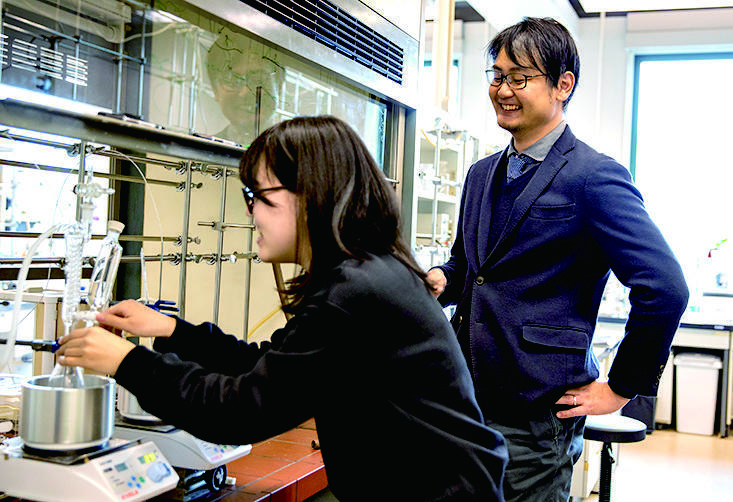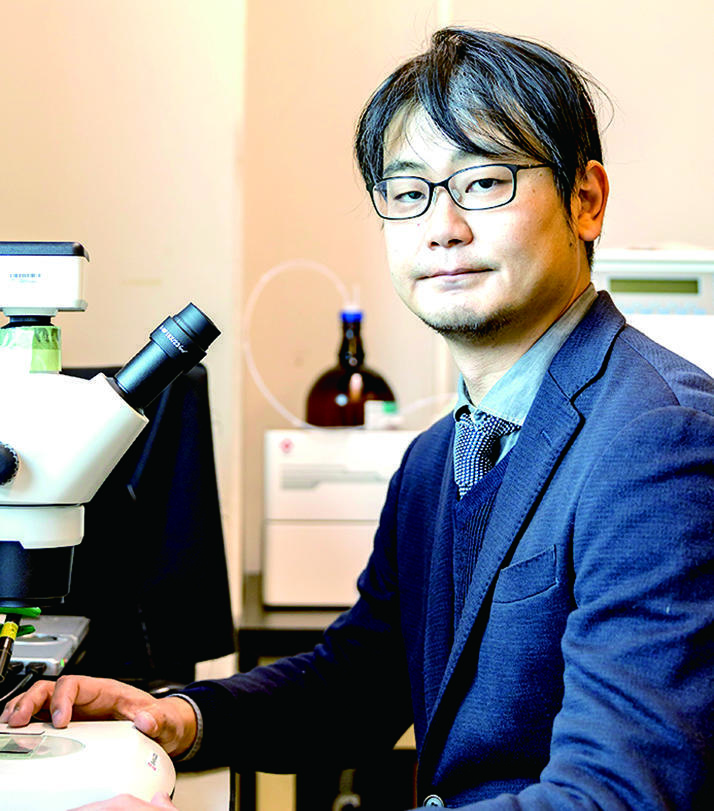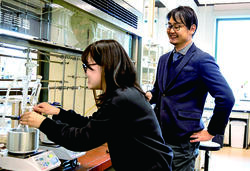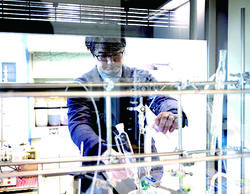- TOP
- Cutting-edge Research and Social Contribution
- Cutting-edge Research
- Opening up new fields of materials chemistry with elastic molecular crystals

Opening up new fields of materials chemistry with elastic molecular crystals

HAYASHI Shotaro
- Specialized field
Crystal Engineering, Polymer Science, Organic Synthesis, Organic Materials Chemistry
Organic materials typically exhibit a trade-off between crystallinity and flexibility--the common-sense view being that organic molecular crystals are not flexible. Associate Professor Hayashi had a feeling that this received wisdom could be overturned, and he noticed slight movements in the crystal structure of π-conjugated molecules, often used as organic photonics and electronics materials due to their unique optical and electronic properties. By using independently discovered design/synthesis strategies for these π-conjugated molecules, he has developed "elastic molecular crystals"--single crystals with flexibility--and produced new materials in which these crystals have light-emitting properties. These results are expected to catalyze new innovations in materials, beyond the scope of polymer materials.
Creating flexible crystals composed of π-conjugated molecules
"π-Conjugated molecules" have garnered attention in recent years as basic materials in the field of organic electronics. The relatively free movement of electrons within these materials results in unusual properties like semiconductivity, conductivity, and light-emission. Dr. Hayashi aims to create new materials going beyond polymers by employing organic/polymer synthesis and molecular assembly chemistry. The key is these π-conjugated molecules.
Organic photonics/electronics materials are broadly classified into two types: small-molecule single crystals and polymer resins. Small-molecule single crystals have a dense, anisotropic structure with tightly packed molecules, promising high performance. However, their low flexibility renders them fragile and prone to breakage. Polymer resins, in contrast, exhibit properties exactly the opposite of single crystals. Although they offer flexibility, attaining optimal performance is hindered by their structure, which contains numerous gaps. This is the common-sense view of the "trade-off between crystallinity and flexibility" in molecular assemblies.
If organic molecular crystal materials could be endowed with flexibility, it would greatly expand the possibilities of organic material chemistry. With that idea in mind, Dr. Hayashi set to work developing new materials combining the advantages of single molecular crystals and polymer materials. Keeping in mind the "slip mechanism" of π-conjugated molecules in crystals, he successfully developed a new material, elastic molecular crystals, with outstanding density, anisotropy, and flexibility by cycling through the molecule design and synthesis process. He also discovered phenomena like chromics in light-emission induced by deformation. There have previously been no reported examples of elastically-deformable single crystals composed of π-conjugated molecules, and Dr. Hayashi announced these elastic crystals as a world first. These new materials with both flexibility and high performance are attracting attention as a route to new possibilities for small-molecule materials and new material innovations. Dr. Hayashi has this to say about the background of the development: "If the inside of a crystal has a crooked structure, the molecules cannot move, but I thought: if there is a mechanism allowing movement, movement should be possible no matter how tightly packed they are. That's when I got the idea of producing a "slip mechanism" for molecules. I noticed the high planarity of π-conjugated molecules, increased their planarity to the limit, crafted a design to prevent molecule twisting and distortion, and then executed that design through repeated synthesis."
When force is applied to the crystal, bending occurs due to its molecular planes shifting in one direction. They then return to their original state. Repeated changes in color also occur due to this characteristic, so Dr. Hayashi is exploring applications in "optical waveguides." These waveguides are used for components like optical fibers that have both high radio wave efficiency and composition.
Dr. Hayashi says what drives him in research is "witnessing new phenomena and the development of new materials." He believes the novel idea of a flexible crystal material may revolutionize materials chemistry. "Creating new materials bridging the gap between single crystals and polymers, with their completely different properties, will blur the boundaries of materials science. I think that's where the potential for innovation lies."
By embracing free thinking in his approach to polymer and crystal materials, Dr. Hayashi is pioneering not only novel materials but also new fields.

Developing fully-recyclable functional fiber materials
Dr. Hayashi is developing fully-recyclable functional fiber materials as one application of elastic crystals.
Fiber materials used in industry are usually made of macromolecule polymers. Unfortunately, large amounts of waste are produced in raw material synthesis, and even recovery and reuse of products incurs costs for washing and processing. Chemical recycling--involving breakdown and recovery on the molecular level--is not easy in terms of methods or costs, and there are limits on conventional recycling systems for synthetic chemical fibers. Small-molecule monomers, on the other hand, can be easily dissolved by organic solvents, allowing full breakdown and recovery of molecular units, but they are fragile and hard to handle as fiber materials.
To overcome such issues, it is crucial to develop new fiber materials that excel in both waste reduction and recycling. Here, Dr. Hayashi conceived the idea of producing functional fibers from small-molecule monomer units by exploiting the flexibility of elastic crystals. The idea is to realize a full recycling process, which cannot be achieved with fiber materials using polymers as a raw material, and exploit the unique functions of single crystal fibers. "While synthesizing elastic crystals, I realized we can produce long, thin crystals with behavior similar to fibers. I thought that perhaps fibers could be produced by leveraging this property effectively."
According to Dr. Hayashi, deliberately inducing elongated crystals in elastic substances causes them to assume a fibrous morphology, and entanglement occurs so they exhibit a light, fluffy texture similar to fibers composed of polymers. By harnessing the efficient light-absorption capabilities of elastic crystals, it may be possible to employ them as functional fiber materials that block UV light. Dr. Hayashi is keen on "advancing towards practical implementation through collaborative research with companies that have expressed an interest."
Before starting his research on crystal engineering, Dr. Hayashi's specialty was polymer science. "I've been very interested in fiber materials for a long time," he says.

Date of posting: March, 2024
